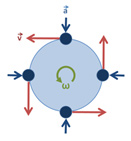
Source: Uniform Circular Motion, Brews O'Hare, Wikimedia
Objects traveling on a circular path generally fall into two broad categories, uniform circular motion and non-uniform circular motion. Uniform circular motion is motion that has a constant angular rate of rotation. An example of uniform motion we see in everyday life is a Ferris wheel.
Non-uniform circular motion involves circular motion that has a changing angular rate of rotation. Examples of non-circular motion that we see in everyday life include roller coasters, and a car going over a hill.

Source: Uniform Circular Motion, Brews O'Hare, Wikimedia
When learning about circular motion, we often learn about two particular topics: centripetal acceleration and circular velocity. Earlier we established an understanding of what circular motion is. Now we will take a moment to learn about mathematical calculations for circular movement by visiting the “Physics Classroom” at the following links:
When you have finished reviewing the information, complete the “Check for Understanding” section at the end of the tutorials.
As you scroll over an equation below, a pop-up box will be displayed explaining the various components of each equation.
![]()